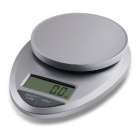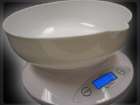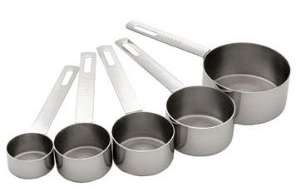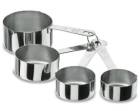How much does a cup weigh?
Having trouble measuring recipe ingredients? Here's the scoop.
This handy chart will help you convert recipe ingredients from volume to weight and vice versa. You can use it for flour, sugar, butter, nuts, beans, pulses, fruit, vegetables and many other items in your kitchen. In each case, it will give you the weight of one US cup of the ingredient (for other conversions, see the notes near the bottom of the page).
Whatever kind of cooking you prefer, we hope you find this chart useful.
| One cup of this ingredient | Weighs approx. this number of ounces | And this number of grams |
| Alfalfa sprouts | 0.75 | 18 |
| Almonds (ground) | 3 | 75 |
| Almonds (whole) | 8 | 225 |
| Avocado (mashed) | 8 | 225 |
| Barley (pearl, uncooked) | 6 | 175 |
| Beans (aduki / adzuki, dry) | 6 | 175 |
| Beans (green, string) | 2.5 - 3.5 | 60 - 100 |
| Beans (mung / moong, dry) | 6 | 175 |
| Beans (other, dry) | 6 - 8 | 175 - 225 |
| Beansprouts | 4 | 110 |
| Blackberries (whole, fresh) | 4 | 110 |
| Blueberries (whole, fresh) | 4 | 110 |
| Brazil nuts (whole, shelled) | 5 | 150 |
| Breadcrumbs (fresh) | 2 - 3 | 50 - 75 |
| Breadcrumbs (packaged) | 4 | 110 |
| Bulgar / Bulgur wheat (uncooked) | 5 | 150 |
| Butter | 8 | 225 |
| Butter (one stick) | 4 | 110 |
| Cabbage (shredded) | 12 | 340 |
| Carrots (coarsely-grated) | 2 - 3 | 50 - 75 |
| Cashew nuts (whole) | 4.5 | 125 |
| Cashew nuts (chopped) | 4 | 110 |
| Cheese (full-fat cream cheese) | 8 | 225 |
| Cheese (hard, shredded) | 2 - 4 | 50 - 110 |
| Cheese (parmesan, finely shredded) | 3.5 | 100 |
| Cheese (soft) | 6 - 8 | 175 - 225 |
| Chocolate chips | 6 | 175 |
| Cocoa powder | 4 | 110 |
| Coconut (shredded, desiccated) | 3 | 75 |
| Cookie crumbs (biscuit crumbs) | 2.5 - 3.5 | 60 - 100 |
| Corn kernels (fresh or frozen) | 4.5 | 125 |
| Cornflakes | 1 | 25 |
| Cornmeal (maize meal) | 5 | 150 |
| Cornstarch (cornflour) | 5 | 150 |
| Couscous (raw) | 6 | 175 |
| Cranberries | 3.5 | 100 |
| Currants | 5 | 150 |
| Dates (chopped) | 5 | 150 |
| Flour (all-purpose, white,self-raising, etc) | 4 | 110 |
| Flour (buckwheat) | 6 | 175 |
| Flour (potato) | 6 | 175 |
| Flour (rice) | 5 | 150 |
| Flour (rye) | 3.5 | 100 |
| Flour (spelt) | 4 | 110 |
| Flour (wheat, wholemeal) | 4.5 | 125 |
| Golden raisins / sultanas | 5 | 150 |
| Hazelnuts (whole) | 6 | 175 |
| Lentils | 5 - 7 | 150 - 200 |
| Nuts (chopped) | 3 - 5.5 | 110 - 165 |
| Margarine | 8 | 225 |
| Mushrooms (chopped) | 3 | 75 |
| Mushrooms (sliced) | 2.5 - 3 | 60 - 75 |
| Oatmeal (fine) | 5.25 | 155 |
| Oatmeal (medium) | 3 | 75 |
| Onions (chopped) | 5 | 150 |
| Pasta, fusilli (uncooked) | 2.5 - 3 | 60 - 75 |
| Pasta, penne (uncooked) | 3 - 3.5 | 75 - 100 |
| Peanut butter | 8 - 10 | 225 - 300 |
| Peanuts (chopped) | 5 | 150 |
| Peanuts (whole, shelled) | 4 | 110 |
| Peas (fresh or frozen) | 4 | 110 |
| Pecans (chopped kernels) | 3.5 | 100 |
| Polenta (fine ground maize) | 5 | 150 |
| Poppy seeds | 4.5 | 125 |
| Potato (shredded) | 8 | 225 |
| Pumpkin purée | 9 | 250 |
| Raisins | 3.5 | 100 |
| Rice (brown long-grain, raw) | 5.5 | 165 |
| Rice (white long-grain, raw) | 5 | 150 |
| Sesame seeds | 4.5 | 125 |
| Sugar (brown or Demerara) | 7 | 200 |
| Sugar (confectioners / icing) | 4.5 | 125 |
| Sugar (superfine / caster) | 6.5 | 190 |
| Sugar (white / granulated) | 7 | 200 |
| Tomatoes (dice) | 6 | 175 |
| Tofu (mashed) | 8 | 225 |
| Walnut pieces | 2.5 - 3.5 | 60 - 100 |
| Zucchini / courgettes (sliced) | 5 - 6 | 150 - 175 |
Why do I need this?
Cooks in the USA usually measure recipe ingredients by volume. The rest of the world favors measuring by weight. Since food items vary in density, you can't use a simple arithmetic formula to translate from one to the other.
To take an obvious example, a cup of alfalfa sprouts will weigh much less than one of sugar. Less obviously, all-purpose white flour weighs less than wheat meal or rye flour. Hence the need for this table.
You should use the table as a rough guide only, as several factors might affect the results: How firmly the flour is packed, how finely the cheese is shredded, and so on. For most recipes, the approximation won't matter. If you're making eggplant parmigiana, for instance, the exact quantity of mozzarella won't be critical (there will be a greater variation in the size of the eggplant). But for other dishes - especially bread, cakes and the like - accuracy is more important.
Note that the chart is based on a standard US cup, which is 240 ml. The metric cup (used in Australia and elsewhere) is about 4% larger.
Other conversions
What if you need to convert between ounces and grams? To do an exact conversion, you would multiply the number of ounces by 28.35. In practice, multiplying by 25 gives a figure that's close enough for most recipes - at least, those that involve small quantities. To convert larger quantities, multiply the number of pounds by 450.
Liquids
In most cases, you won't need to use our table for milk, apple juice, olive oil or other liquids, as most recipes list liquid ingredients by volume. You might occasionally see a recipe that calls for so-many grams of, say, yogurt, but this is rare.
Just keep in mind that a US cup is 240 ml, which is almost exactly eight fluid ounces, a fluid ounce being approximately 30 ml.
By the way, you don't need to worry about any of this if you are using the excellent recipes here on Veg World. These all list their ingredients in cups, imperial and metric.
What else is here?
If you enjoy cooking as much as we do, be sure to browse the rest of our site. We've got recipes for some great vegetarian and vegan main course dishes, snacks, desserts and home baking. There are also articles on good food, cooking techniques and healthy eating. Meantime, we hope you'll find this page useful for working out how much of each ingredient to use when preparing your favorite recipes. Happy cooking.
First published: June 2003. Last checked and updated: June 2011




